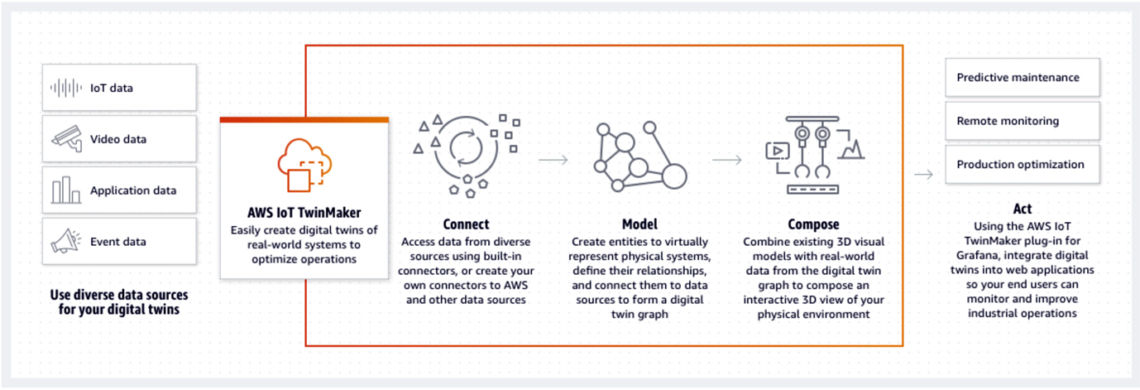AWS makes it easier to create digital twins
- April 27, 2022
- Steve Rogerson
Amazon Web Services (AWS) has announced IoT TwinMaker, a service that makes it faster and easier for developers to create digital twins of real-world systems such as buildings, factories, industrial equipment and production lines.
Digital twins are virtual representations of physical systems that use real-world data to mimic the structure, state and behaviour of the objects they represent and are updated with new data as conditions change.

AWS IoT TwinMaker makes it easier for developers to integrate data from multiple sources such as equipment sensors, video cameras and business applications, and combines those data to create a knowledge graph that models the real-world environment. With IoT TwinMaker, many more can use digital twins to build applications that mirror real-world systems that improve operational efficiency and reduce downtime.
There are no upfront commitments or fees to use IoT TwinMaker, and users only pay for accessing the data used to build and operate digital twins.
Industrial companies collect and process vast troves of data about their equipment and facilities from sources such as equipment sensors, video cameras and business applications. Many want to combine these data sources to create a virtual representation of their physical systems to help them simulate and optimise operational performance. But building and managing digital twins is hard even for the most technically advanced organisations.
To build digital twins, users must manually connect different types of data from diverse sources then create a knowledge graph that provides common access to all the connected data and maps the relationships between the data sources to the physical environment. To complete the digital twin, they have to build a 3D virtual representation of their physical systems and overlay the real-world data on to the 3D visualisation, and then ensure the digital twin is kept up to date as conditions change.
Once they have a virtual representation of their real-world systems with real-time data, they can build applications for plant operators and maintenance engineers who can leverage machine learning and analytics to extract business insights about the real-time operational performance of their physical systems. Because the work required is complex, the vast majority of organisations are unable to use digital twins to improve their operations.
IoT TwinMaker makes it faster and easier to create digital twins of real-world systems. Developers can get started quickly building digital twins of devices, equipment and processes by connecting IoT TwinMaker to data sources such as equipment sensors, video feeds and business applications. It contains built-in connectors for Amazon Simple Storage Service (Amazon S3), AWS IoT SiteWise and Amazon Kinesis Video Streams, or users can add their own connectors for data sources such as Amazon Timestream, Snowflake and Siemens MindSphere, to make it easy to gather data from a variety of sources.
IoT TwinMaker automatically creates a knowledge graph that combines and understands the relationships of the connected data sources, so it can update the digital twin with real-time information from the system being modelled. Users can import existing 3D models directly to create 3D visualisations of the physical system and overlay the data from the knowledge graph on to the 3D visualisations to create the digital twin.
Once the digital twin has been created, developers can use an IoT TwinMaker plugin for Amazon Managed Grafana to create a web-based application that displays the digital twin on the devices plant operators and maintenance engineers use to monitor and inspect facilities and industrial systems. For example, developers can create a virtual representation of a metals processing plant by associating data from the plant’s equipment sensors with real-time video of the various machines in operation and the maintenance history of those machines.
Developers can then set up rules to alert plant operators when anomalies in the plant’s furnace are detected, such as a temperature threshold being breached, and display those anomalies on a 3D representation of the plant with real-time video from the furnaces, which can help operators make quick decisions on predictive maintenance before a furnace fails.
“Sensors for equipment, buildings and industrial processes are proliferating and generating massive amounts of data” said Michael MacKenzie, general manager for IoT at AWS. “Customers are increasingly eager to use those data to optimise their operations and processes and one way to do that is using digital twins, but they find that building a digital twin and custom applications is difficult, time consuming and prohibitively expensive to maintain today. With AWS IoT TwinMaker, customers can now derive previously unavailable insights about their operations that inform real-time improvements to their buildings, factories, industrial equipment and production lines, and make accurate predictions about system behaviour with minimal effort.”
Siemens Digital Industries Software specialises in digital twins that connect information technology and operational technology across the entire product lifecycle through design, manufacturing, production and service.
“Through this collaboration, we can leverage AWS IoT TwinMaker and other AWS services within the low-code, data management, visualisation, simulation and industrial IoT applications in our Xcelerator portfolio, making it easier for customers to create digital twins that can scale from the simplest to the most complex use cases,” said Brenda Discher, senior vice president at Siemens Digital Industries Software. “Together, we are helping our customers increase manufacturing productivity and flexibility, optimise material costs, and better meet their energy and sustainability goals.”




